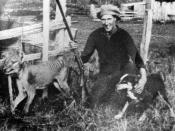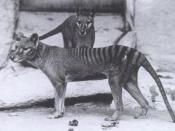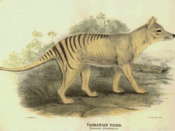The Tasmanian Tiger (Thylacinus cynocephalus)
The Tasmanian Tiger is assumed extinct. The last known specimen died in a Hobart, Tasmania zoo in 1936. Humans were responsible for the extinction, which only took about 70 years, as farmers in the 1800s began shooting, poisoning, gassing, and trapping the animal, blaming it for attacking sheep.
A slender, fox-faced animal, the Tasmanian wolf was 100 to 130 cm long, including its 50- to 65-centimetre tail which was very thick, close to the body and quickly tapered to a point. The Tasmanian wolf was yellowish brown, with about 16 to 18 dark vertical bars on the back and rump and short, thick fur. In a shallow pouch, opening rearward, the female carried two to four young at a time. Their feet have five toes which are padded. Their teeth are also very similar to those of a dog. It was about 60 cm tall at the shoulder.
The Tasmanian Tiger liked to live in open forests and grasslands, widespread over continental Australia, extending north to Papua New Guinea and south to Tasmania. But towards the end of the species' existence it became confined to dense rainforests In Tasmania. Tasmanian Tigers had lairs which were located mainly in hollow logs or rock outcropping in hilly areas that were adjacent to open areas like grasslands.
It probably hunted alone at night for wallabies and birds. Some believe it was an ambush hunter, while others think it chased it's prey until it became exhausted. It's breeding season was autumn, gave birth all year round, especially in summer. The young probably stayed in the pouch for 2-3 months and with the mother for a following 6 months. It had many different calls, such as a rough bark for hunting, a deep growl brought on when it became irritated,



From the author
Unfortunately I could not get the site to accept the diagrams which go along with this text, and could not figure out how to change the title. If you need these pictures, or can tell me how to change the essay title so as not to include the note about photos/diagrams, please message me. Thanks.
0 out of 0 people found this comment useful.